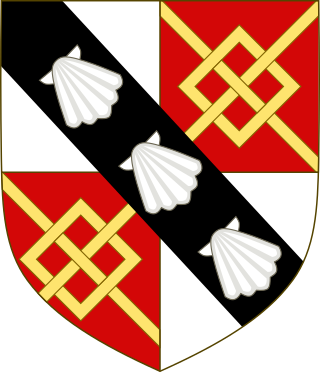Related Research Articles

The Spencer family is an aristocratic family in the United Kingdom. From the 16th century, its members have held numerous titles including the dukedom of Marlborough, the earldoms of Sunderland and Spencer, and the Churchill barony. Two prominent members of the family during the 20th century were Sir Winston Churchill and Diana, Princess of Wales.

Earl of Lucan is a title which has been created twice in the Peerage of Ireland for related families, first for Patrick Sarsfield by the deposed King James VII & II in 1691, which has no legal recognition in UK law, and later for Sarsfield's great-nephew, Charles Bingham, in 1795. The title is associated with Baron Lucan and Baron Bingham, which allowed the Earls of Lucan to sit in the House of Lords. The title became infamous due to the 3rd Earl's involvement in the Charge of the Light Brigade during the Crimean War and the disappearance of the 7th Earl in 1974, who was found guilty of murder in absentia. The 7th Earl was declared legally dead in 1999, and his son was allowed to succeed to the title in 2016 after a death certificate was issued. The family seats were Castlebar House in County Mayo, and Laleham House in Surrey.

Patrick Sarsfield, 1st Earl of Lucan, born c.1655 – 21 August 1693), was an Irish soldier, and leading figure in the Jacobite army during the 1689 to 1691 Williamite War in Ireland.

James Albert Edward Hamilton, 3rd Duke of Abercorn, styled Marquess of Hamilton between 1885 and 1913, was a British peer and Unionist politician. He was the first Governor of Northern Ireland, a post he held between 1922 and 1945. He was a great-grandfather of Diana, Princess of Wales.

George Charles Bingham, 8th Earl of Lucan, styled Lord Bingham until 2016, is a British hereditary peer. He is a paternal third cousin of Diana, Princess of Wales.
Sir Rory O'Moore, also known Sir Roger O'Moore or O'More or Sir Roger Moore, was an Irish landowner, and is most notable for being one of the four principal organizers of the Irish Rebellion of 1641.

Colonel George Charles Bingham, 5th Earl of Lucan, 1st Baron Bingham,, known by the courtesy title of Lord Bingham from 1888 to 1914, was a British soldier and Conservative politician.His sister Rosalind Hamilton, Duchess of Abercorn, was a paternal great-grandmother of Diana, Princess of Wales.
Theobald Taaffe, 1st Earl of Carlingford, known as 2nd Viscount Taaffe, of Corren and 2nd Baron of Ballymote between 1642 and 1661, was an Irish Royalist officer who played a prominent part in the Wars of the Three Kingdoms. Following the outbreak of the Irish Rebellion of 1641, the Catholic Taaffe remained loyal to the authorities in Dublin. He later joined the Irish Confederates, and was awarded command of the Munster Army. Taaffe was a supporter of the moderate faction, and strongly supported an alliance between the Confederates and Irish Royalists. After the Cromwellian conquest of Ireland, Taaffe accompanied Charles II in exile. Following the Restoration, he was created 1st Earl of Carlingford.
Turnings is a townland and historic site in County Kildare, Ireland, situated on the banks of the Morell River, a tributary of the River Liffey 25 km upstream from the Irish capital Dublin. It is a rural area, and a planning application has been lodged with Kildare County Council (2007) to develop a town in the district.

Sir Theophilus Jones, was an Irish soldier and government official of Welsh descent. One of five sons born to Lewis Jones, Bishop of Killaloe in the Church of Ireland, he formed part of a close-knit and powerful Protestant family.
Sir William Sarsfield was an Irish landowner, public official and soldier of the sixteenth century.
Peter Sarsfield was an Irish landowner of the seventeenth century.
Terence O'Dempsey, 1st Viscount Clanmalier was an Irish aristocrat.
Lewis O'Dempsey, 2nd Viscount Clanmalier was an Irish aristocrat of the seventeenth century.
Patrick Sarsfield was an Irish landowner and soldier of the seventeenth century noted for his role in the Irish Confederate Wars. He is best known as the father of Patrick Sarsfield, Earl of Lucan, and is sometimes referred to as Patrick Sarsfield the Elder because of this.

Lucan Manor is a Georgian-Palladian house and estate in Lucan, County Dublin. A manor house, it is remembered particularly for its association with the Sarsfield family. A castle or house has been recorded on the site since at least the 12th century.

Honora Burke, married Patrick Sarsfield and went into French exile where he followed her soon afterwards. After his death at the Battle of Landen, she married James FitzJames, 1st Duke of Berwick, an illegitimate son of James II. She may have introduced the country dance to the French court.
Francis Sarsfield was an Irish lawyer and landowner of the seventeenth century.
James Sarsfield, 2nd Earl of Lucan (1693-1719), was a French-born Jacobite of Irish descent.
Agmondisham Vesey was an Irish landowner.
References
- ↑ Wauchope pp. 9-10
- ↑ Robin Clifton, "Walter, Lucy (1630?–1658)" in Oxford Dictionary of National Biography (online edition, Oxford University Press, 2006), doi:10.1093/ref:odnb/28639 (subscription required)